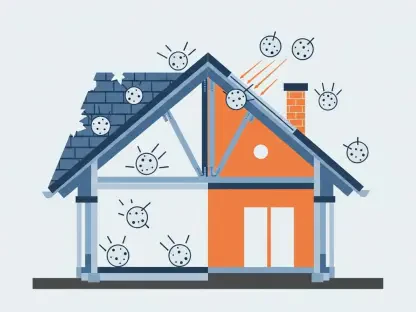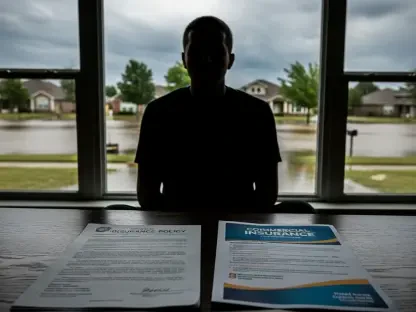Navigating the aftermath of a disaster like a hurricane or house fire often leaves policyholders in a vulnerable state, grappling with emotional stress and financial uncertainty while facing off against insurance companies equipped with vast resources and strategic tactics. These insurers may employ methods designed to reduce payouts or outright deny claims, placing claimants at a significant disadvantage. For many, the claims process feels like a treacherous path where a single misstep can jeopardize the chance to rebuild. This article delves into the critical errors that frequently undermine insurance claims, offering insights from industry experts to help protect policyholder rights and secure deserved settlements. Understanding these pitfalls is essential, as small oversights can lead to denied coverage or insufficient funds for recovery. By shedding light on common mistakes, the goal is to empower claimants to approach the process with clarity and caution, turning a potentially contentious battle into a manageable journey toward restoration.
Identifying Key Errors in Filing Claims
Critical Misstep: Speculating Under Pressure
The pressure to respond immediately after a disaster can lead policyholders to make hasty statements to insurers without fully understanding the implications. Often, in an attempt to seem cooperative, individuals provide guesses about the extent of damage or the cause of a loss when questioned by adjusters. These responses, though well-intentioned, are documented as factual by insurance representatives and can later be used to challenge the validity of a claim. Such discrepancies might result in reduced payouts or complete denials if the initial statements conflict with professional evaluations. Experts strongly recommend pausing before answering and ensuring that only verified information is shared. This deliberate approach helps maintain the integrity of the claim and prevents insurers from exploiting uncertainties, which could otherwise prolong disputes and hinder recovery efforts. Taking time to gather accurate details is not a delay tactic but a necessary step to safeguard one’s position in the claims process.
Another layer of complexity arises when policyholders are unaware of how their words can be weaponized against them during insurer interrogations. The emotional toll of a disaster often clouds judgment, making it tempting to fill in gaps with assumptions rather than admitting uncertainty. However, adjusters rarely note that a statement was speculative, treating it instead as a definitive account that could undermine later evidence. This can create a ripple effect, where an innocent guess about, say, the origin of structural damage becomes a point of contention that delays settlements. The advice from seasoned professionals is clear: silence is preferable to speculation. Waiting for expert assessments, such as those from contractors or engineers, ensures that the information provided aligns with reality. This patience not only protects the claim from being derailed by inconsistencies but also builds a stronger case for fair compensation, reinforcing the importance of measured communication in high-stakes situations.
Dangerous Temptation: Overstating Losses
Frustration with slow insurer responses or inadequate initial offers can push policyholders into a risky decision—exaggerating the value of their losses to compensate for perceived unfairness. Surveys have revealed that a significant number of insured individuals contemplate inflating claims, believing it might balance the scales against corporate tactics. Yet, this approach carries severe consequences, as even a minor embellishment, such as overstating the worth of a damaged appliance, can give insurers grounds to void the entire claim. Such actions not only jeopardize coverage for all losses but also expose claimants to potential legal repercussions. Industry voices consistently emphasize that integrity is paramount, as honesty preserves the legitimacy of the claim and maintains the policyholder’s right to pursue fair resolution. Sticking to factual reporting, no matter how frustrating the process, remains the safest path to securing what is rightfully owed.
Beyond the ethical concerns, inflating claim values often stems from a misunderstanding of how insurers scrutinize every detail for inconsistencies. A single discrepancy, like claiming a higher replacement cost than market value, can trigger a deeper investigation, casting doubt on the entire submission. Insurers are trained to spot red flags, and once trust is broken, they may deny coverage not just for the exaggerated item but for all damages, leaving policyholders with nothing. This harsh reality underscores the need for transparency, even when the temptation to pad numbers feels justified by delays or lowball offers. Experts advocate for documenting losses meticulously and presenting only verifiable evidence, as this builds a credible case that withstands scrutiny. By resisting the urge to overstate claims, policyholders protect themselves from catastrophic outcomes and ensure that their genuine losses are addressed, fostering a process grounded in trust rather than suspicion.
Costly Oversight: Undervaluing Repair Estimates
A frequent error in the claims journey is the submission of low-cost contractor bids, often driven by a desire to appear proactive or frugal in the eyes of the insurer. Many policyholders, unfamiliar with the nuances of insurance claims, treat property damage as they would routine home repairs, seeking out the cheapest estimates without considering long-term implications. Insurers are quick to latch onto these undervalued bids as a benchmark for payouts, which can result in insufficient funds to cover proper restoration. This often leads to substandard repairs that fail to address underlying issues, leaving homes vulnerable to further damage. Guidance from professionals highlights the importance of engaging licensed contractors with specific experience in insurance claims, as their detailed and accurate estimates reflect the true cost of rebuilding. This approach ensures that settlements align with actual needs rather than artificially low figures that benefit the insurer.
Equally problematic is the assumption that quick, inexpensive bids will expedite the claims process, when in reality, they often prolong it due to disputes over inadequate funding. Policyholders may find themselves stuck with contractors who cut corners to meet the low estimate, resulting in work that doesn’t meet safety or quality standards. When repairs inevitably fail or additional damage emerges, insurers may refuse to revisit the claim, arguing that the initial payout was based on the provided bid. To avoid this trap, it’s crucial to prioritize quality over speed, selecting contractors who can justify their pricing with detailed breakdowns and defend their assessments if challenged. Such diligence prevents insurers from capping compensation at unrealistic levels and supports a restoration process that truly makes the property whole again. Taking the time to secure reputable estimates is an investment in both the claim’s success and the home’s future stability.
Strategies for a Stronger Claims Process
Building a Solid Foundation: Accurate Documentation
One of the most effective ways to navigate the insurance claims maze is through meticulous documentation of all losses and interactions with the insurer. From the moment damage occurs, policyholders should catalog every affected item, taking photographs, retaining receipts, and noting any temporary repairs made to mitigate further harm. This comprehensive record serves as undeniable evidence of the scope of loss, countering any attempts by insurers to downplay the extent of damage. Beyond physical evidence, keeping a log of all communications with adjusters, including dates and summaries of discussions, adds another layer of protection against misrepresentations. Experts stress that such thoroughness not only strengthens the claim but also demonstrates a commitment to transparency, which can discourage insurers from employing delay tactics. A well-documented case stands as a formidable barrier to unfair denials or reduced settlements, paving the way for a smoother resolution.
Another vital aspect of documentation lies in its role as a safeguard against memory lapses or emotional overwhelm during the claims process. Disasters often leave individuals scattered, making it easy to forget critical details about damaged property or the sequence of events leading to a loss. By systematically recording everything—from the condition of a flooded basement to the value of lost electronics—policyholders create a reliable reference that prevents inconsistencies in their statements. This practice also aids in collaboration with professionals like contractors or legal advisors, providing them with clear data to build a robust case. Furthermore, detailed records can expedite assessments by giving adjusters a clear picture of the claim’s validity, reducing back-and-forth disputes. Emphasizing accuracy and completeness in documentation transforms a potentially chaotic process into a structured one, ensuring that every legitimate loss is accounted for and fairly compensated without unnecessary hurdles.
Leveraging Expertise: Professional Support
Engaging qualified professionals can significantly tilt the balance in favor of policyholders during the complex claims process. Experienced contractors, public adjusters, or legal advocates bring specialized knowledge that counters the expertise insurers wield, ensuring that claims are neither undervalued nor unjustly denied. These experts understand the intricacies of policy language and industry standards, enabling them to challenge lowball offers or improper denials with evidence-based arguments. Their involvement often deters insurers from exploiting policyholder inexperience, as the presence of a professional signals a readiness to fight for a fair outcome. Recommendations from industry leaders highlight that investing in such support, though initially costly, often yields higher settlements that far outweigh the expense, making it a strategic move for anyone facing significant losses after a disaster.
Additionally, professional support offers a buffer against the emotional and logistical burdens that accompany filing a claim, allowing policyholders to focus on recovery rather than bureaucratic battles. Navigating insurance policies, with their dense terminology and hidden clauses, can be daunting for those unversed in the field, often leading to overlooked entitlements or procedural errors. Experts not only interpret these documents but also anticipate insurer strategies, preparing responses that protect the claimant’s interests. Their ability to negotiate directly with adjusters or represent policyholders in disputes adds a layer of confidence, reducing the likelihood of being pressured into accepting inadequate settlements. This partnership transforms the claims experience from an uphill struggle into a collaborative effort, where informed guidance ensures that every step taken aligns with the goal of securing just compensation for the damages incurred.
Reflecting on Past Challenges: Lessons Learned
Looking back, countless policyholders found themselves ensnared by avoidable errors that turned their path to recovery into prolonged battles with insurers. Many fell into the trap of speculating about damages during initial interviews, only to see those uncertain statements used to slash their payouts. Others, out of frustration, padded their claims, risking complete voiding of coverage over minor exaggerations. Still more submitted rushed, low-cost bids, locking themselves into insufficient funds for proper repairs. These past struggles underscored a harsh truth: the claims process was often stacked against the unprepared, with insurers capitalizing on every misstep. Reflecting on these experiences revealed the critical need for caution, transparency, and professional input to counter systemic disadvantages, shaping a clearer understanding of how to approach such challenges with greater resilience.
The lessons from these earlier encounters also highlighted that empowerment through education was a game-changer for many who later navigated claims successfully. By studying past mistakes, policyholders learned to prioritize accurate documentation, resist the urge to overstate losses, and seek reputable contractors for realistic estimates. These insights, drawn from real-world outcomes, proved that a deliberate and informed approach could mitigate the risks of denial or underpayment. Moving forward, the focus should be on applying these hard-earned lessons—ensuring every interaction with insurers is measured, every claim is rooted in fact, and every decision is supported by expertise. Taking proactive steps, such as building a robust paper trail and consulting professionals early, offers a blueprint for future claims, transforming past setbacks into actionable strategies that secure fair resolutions and lasting recovery.









